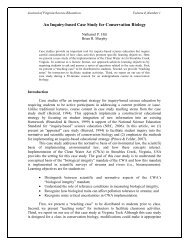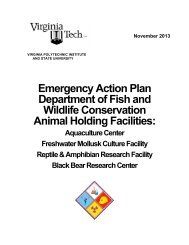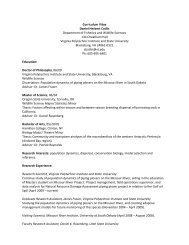348 THE AMERICAN MIDLAND NATURALIST 163(2)TABLE 5.—Locality <strong>and</strong> population density data <strong>of</strong> Lemiox rimosus at selected sites in the Clinch <strong>and</strong>Duck rivers, TN. ND 5 individuals not detected in quadrat samples <strong>and</strong> NC 5 not calculatedQuadratsRiver Year (s) sampled Number Density Site PopulationSite locations kilometer sampled y 21 (n) collected m 22 (SD) area (m 22 ) size (95% CI)Clinch River:Wallen Bend(upper)309.6 2004 a 60 1 0.066 (0.516) 3183 210 (6415)2005 a 60 0 ND NC2006 a 60 1 0.066 (0.516) 210 (6415)2007 a 60 1 0.066 (0.516) 210 (6415)Kyles Ford 305.2 2004 b 146 7 0.190 (0.976) 15,000 2850 (62443)Frost Ford 291.7 2004 a 60 2 0.133 (0.724) 15,050 2002 (62756)2005 a 60 1 0.066 (0.516) 993 (61964)2006 a 60 4 0.266 (1.004) 4003 (63821)2007 a 60 0 ND NCSwan Isl<strong>and</strong> 277.2 2004 a 60 0 ND 5746 NC2005 a 60 0 ND NC2006 a 60 1 0.066 (0.516) 379 (6750)2007 a 60 0 ND NCDuck River:Lillard Mill 288.0 2006 c 254 90 1.42 (4.485) 22,500 22,500 (63931)Venable Spring 285.3 2004 d 285 46 0.650* 4500 2925Hooper Isl<strong>and</strong> 262.3 2006 c 169 27 0.639 (1.594) 49,000 29,400 (611,776)a Jones, J.W. 2004–2007. U.S. Fish <strong>and</strong> Wildlife Service, unpublished datab Ostby, B.J.K. 2005c Ostby, B.J.K., <strong>and</strong> R.J. Neves. 2007d Adair, B.D. 2005* St<strong>and</strong>ard deviation was not available, but likely similar to samples collected at Hooper Isl<strong>and</strong>Based on current population structure <strong>and</strong> trends, we believe that both the Clinch <strong>and</strong>Duck river populations <strong>of</strong> Lemiox rimosus are experiencing recruitment <strong>and</strong> are currentlystable. These populations should remain viable as long as habitat, water quality <strong>and</strong>ecological conditions are maintained in these rivers. The Clinch River population has beenat low densities (,0.5 m 22 ) for several decades, a trend that is likely to continue.Interestingly, Ortmann (1918) considered the species rare in the river in the early 1900s.Hence, the rarity <strong>of</strong> the species is seemingly natural, making monitoring a challenge.Finally, a remnant population <strong>of</strong> L. rimosus still resides in the Powell River in Tennessee <strong>and</strong>Virginia. Individuals occur at very low densities (,0.01 m 22 ) at sites <strong>of</strong> occurrence, butgravid females <strong>and</strong> young adults (#4 y) recently (2004–2007) have been observed in theriver. The viability <strong>of</strong> this population is unknown, but evidence <strong>of</strong> gravidity <strong>and</strong> recruitmentis encouraging.Conservation recommendations.—Recovery <strong>of</strong> Lemiox rimosus will require protection <strong>and</strong>expansion <strong>of</strong> existing populations, <strong>and</strong> establishment <strong>of</strong> additional populations intohistorically occupied habitat. A genetic analysis is needed to determine whether levels <strong>of</strong>divergence between the Clinch <strong>and</strong> Duck river populations warrant separate managementunits. However, utilizing the high abundance in the latter population as broodstockrepresents the best opportunity to recover the species throughout the Tennessee Riverbasin. Therefore, it is critical that water releases from Norm<strong>and</strong>y Dam be maintained at flow
2010 JONES ET AL.: BIRDWING PEARLYMUSSEL LIFE HISTORY AND DEMOGRAPHY 349<strong>and</strong> temperature levels that will continue to produce sustainable population recruitment <strong>of</strong>the species in the river.Acknowledgments.—This study was funded by Tennessee Wildlife Resources Agency, Nashville,Tennessee, Tennessee Valley Authority <strong>and</strong> U.S. Fish <strong>and</strong> Wildlife Service (USFWS), Asheville, NorthCarolina. The Virginia Cooperative Fish <strong>and</strong> Wildlife Research Unit is supported jointly by the U.S.Geological Survey, Virginia Department <strong>of</strong> Game <strong>and</strong> Inl<strong>and</strong> Fisheries, Wildlife Management Institute<strong>and</strong> Virginia Polytechnic Institute <strong>and</strong> State University. The authors would like to thank Dr. MichaelGangl<strong>of</strong>f (Appalachian State University) <strong>and</strong> Jeff Powell (USFWS) for providing shells <strong>of</strong> Lemiox rimosusfrom the Duck River, <strong>and</strong> Dr. Braven Beaty (The Nature Conservancy) <strong>and</strong> the anonymous referees fortheir comments <strong>and</strong> suggestions for improving the manuscript.LITERATURE CITEDADAIR, B. D. 2005. Patterns in the distribution <strong>of</strong> adult <strong>and</strong> juvenile freshwater mussels(Bivalvia:Unionidae) within a bed. M.S. Thesis, Tennessee Technological University, Cookeville.AHLSTEDT, S.A.AND J. J. JENKINSON. 1987. A mussel die-<strong>of</strong>f in the Powell River, Virginia <strong>and</strong> Tennessee, in1983, p. 21–28. In: R. J. Neves (ed.). Proceedings <strong>of</strong> the Workshop on Die-<strong>of</strong>fs <strong>of</strong> FreshwaterMussels in the United States. Virginia Polytechnic Institute <strong>and</strong> State University, Blacksburg.———. 1991. Cumberl<strong>and</strong>ian mollusk conservation program: mussel surveys in six Tennessee Valleystreams. Walkerana, 5:123–160.——— AND J. D. TUBERVILLE. 1997. Quantitative reassessment <strong>of</strong> the freshwater mussel fauna in theClinch <strong>and</strong> Powell rivers, Tennessee <strong>and</strong> Virginia, p. 72–97. In: K. S. Cummings, A. C.Buchanan, C. A. Mayer <strong>and</strong> T. J. Naimo (eds.). Conservation <strong>and</strong> management <strong>of</strong> freshwatermussels II. Upper Mississippi River Conservation Committee, Rock Isl<strong>and</strong>, Illinois.———, J. R. POWELL, R.S.BUTLER, M.T.FAGG, D.W.HUBBS, S.F.NOVAK, S.R.PALMER AND P. D. JOHNSON.2004. Historical <strong>and</strong> current examination <strong>of</strong> freshwater mussels (Bivalvia: Margaritiferidae,Unionidae) in the Duck River basin Tennessee. Final Report, Tennessee Wildlife ResourcesAgency, Nashville, Tennessee.———, M. T. FAGG, R.S.BUTLER AND J. E. CONNELL. 2005. Long-term trend information for freshwatermussel populations at twelve fixed-station monitoring sites in the Clinch <strong>and</strong> Powell Rivers <strong>of</strong>eastern Tennessee <strong>and</strong> southwestern Virginia. Final Report, U.S. Fish <strong>and</strong> Wildlife Service,Ecological Services, Cookeville, Tennessee.BRUENDERMAN, S.A. AND R. J. NEVES. 1993. Life history <strong>of</strong> the endangered fine-rayed pigtoe (Fusconaiacuneolus) (Bivalvia: Unionidae) in the Clinch River, Virginia. Am. Malacolog. Bull., 10:83–91.CLARK, G. R. 1980. Study <strong>of</strong> molluscan shell structure <strong>and</strong> growth lines using thin sections, p. 603–606.In: D. C. Rhoads <strong>and</strong> R. A. Lutz (eds.). Skeletal growth in aquatic organisms. Plenum Press,New York.ETNIER, D.A.AND W. C. STARNES. 1993. The fishes <strong>of</strong> Tennessee. University <strong>of</strong> Tennessee Press, Knoxville,Tennessee.HILL, D. M. 1986. Cumberl<strong>and</strong>ian Mollusk Conservation Program, Activity 3: Identification <strong>of</strong> fish hosts.Office <strong>of</strong> Natural Resources <strong>and</strong> Economic Development, Tennessee Valley Authority,Knoxville, Tennessee.HOGGARTH, M. A. 1999. Descriptions <strong>of</strong> some <strong>of</strong> the glochidia <strong>of</strong> the Unionidae (Mollusca: Bivalvia).Malacologia, 41:1–118.JENKINS, R.E. AND N. M. BURKHEAD. 1994. Freshwater fishes <strong>of</strong> Virginia. American Fisheries Society,Bethesda, Maryl<strong>and</strong>.JONES, J. W., R. A. MAIR AND R. J. NEVES. 2005. Factors affecting survival <strong>and</strong> growth <strong>of</strong> juvenile freshwatermussels (Bivalvia: Unionidae) cultured in recirculating aquaculture systems. N. Am. J. Aquacul.,67:210–220.———, R. J. NEVES, S.A.AHLSTEDT AND R. A. MAIR. 2004. Life history <strong>and</strong> propagation <strong>of</strong> the endangereddromedary pearlymussel, Dromus dromas (Bivalvia: Unionidae). J. N. Am. Benthol. Soc.,23:515–525.









